Multiple Sclerosis
Last updated 24-04-2023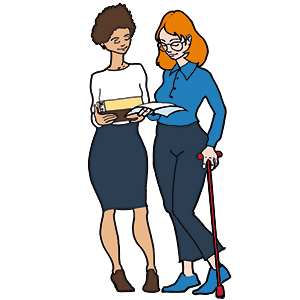 For many people with multiple sclerosis (MS), assistive products are essential to compensate for disabilities deriving from the disease. This could be, e.g. assistive products for mobility and assistive products for personal care and for everyday activities. In addition to this, assistive products for planning and memory support may be essential.
For many people with multiple sclerosis (MS), assistive products are essential to compensate for disabilities deriving from the disease. This could be, e.g. assistive products for mobility and assistive products for personal care and for everyday activities. In addition to this, assistive products for planning and memory support may be essential.Most people who suffer from MS are between 20 and 40 years old at the onset of the diseases. MS is hereditary, but other factors may also be significant. In Denmark, there are almost 18.000 persons with MS. In recent years, there has been an increase in the incidence of MS, mostly among women.
The most frequent symptoms of MS are fatigue and exhaustion physically and/or mentally, unsteady balance, reduced strength in the arms and legs, sensory disturbances in parts of the body, and cognitive and visual disturbances.
MS is a progressive neurological disorder in which the body’s own antibodies and immune cells attack the myelin in the brain and spinal cord. The myelin is cells that function as insulation around the nerve fibres in the brain and spinal cord.
The symptoms of the disease depend on where in the brain and spinal cord the myelin has been attacked and how advanced the disease is. Depending on what kind of impairments the disease causes, various assistive products can be relevant.
Relief and support for the body
Some of the everyday activities that may be difficult to perform due to MS can be made easier by using an assistive product dedicated for carrying out the activity. In other cases, an assistive product can relieve or support your body so that you avoid overload, reduce pain, support your strength and balance or increase your stamina.
Need to sit down
If you have reduced strength in your legs or you have difficulty keeping your balance when standing, standing activities can be exhausting and in some cases result in a risk of falling. Therefore, for activities that you usually carry out standing, you may consider using a standing chair or an activity chair so that you can carry out the activity in a sitting position.
You can read more about this in the guide Activity Chairs.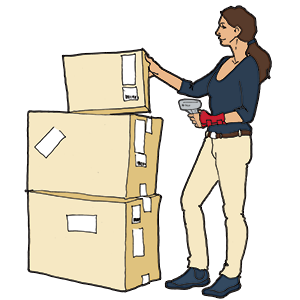
Need for support to your hand or wrist
MS can make it difficult for you to maintain an appropriate position in your wrist during activities. For instance, if you have difficulty bending your wrist upwards, it can be difficult to grasp and hold on to objects. In this case, you can benefit from wearing a wrist orthosis, which can support and stabilize your wrist in a functional position so that you can carry out everyday tasks more easily. For that matter, you may also need support for your hand or your fingers.
Read more in the guide Wrist, Thumb and Finger Orthoses.
Operation and adaptation of the surroundings
If you find it difficult to get around in your home, or if your range of motion is limited, you can look into remote control and SmartHome solutions. It may also be relevant to rearrange the furniture in your home and look at the accessibility to your home.
Remote control and SmartHome solutions
If you find it difficult to operate functions in your home, there are many options for remotely operating devices and functions, such as lights, curtains, and music systems. Many solutions use Wi-Fi or Bluetooth, and you can operate them by using an app or a remote control that is connected to Bluetooth or Wi-Fi. Bluetooth and Wi-Fi connected remotes are not directional. Wi-Fi connected remote controls can be used to operate devices even if you are not in your home, as long as both the device and the remote control are connected to Wi-Fi. If the connection between the remote control and the device is only Bluetooth-based, there will be a limited operation range. 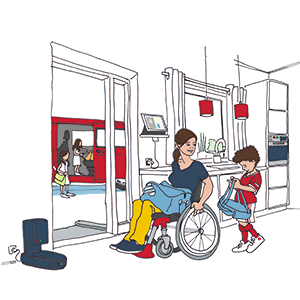
Read more about these solutions in the guide SmartAT for Household and Daily Life.
There are also handheld infrared remote controls with a special design, e.g. distinct buttons, large buttons, or soft buttons. Some of these can be programmed to operate several different devices in the home. Infrared remote controls are directional. This means that you have to point an infrared remote control at the device you want to operate.
Adaptations in and around the home
To facilitate movement in and around your home, you may need to compensate for differences in level. At stairs and thresholds, ramps or skids can be installed, which can make it easier to move about, whether you use a wheelchair or a rollator. Skids and ramps are available both as stationary and as movable products.
Furthermore, height adjustment of furniture as well as handles, handrails, and sensor-activated lighting may be relevant.
Personal hygiene
If you have reduced strength or have difficulty holding on to objects with your hands, specially designed hair and bath brushes may be relevant. Bath brushes with long handles can also make washing yourself easier if you have reduced mobility. There are nail clippers mounted on a plate, which makes it easier to cut your nails if you have little strength or fine motor challenges.
Read more in the guide Small Assistive Products for Personal Care.
If you are unsteady on your feet when you a shower, a bath stool, a folding shower seat, or grab bars mounted on the wall may be relevant.
Read more in the guide Bath Stools, Bath Chairs and Folding Shower Seats and in the guide Grab Bars, Handrails, and Toilet Arm Supports.
If you use a bathtub, you can use a bathtub board, which is placed across the sides of the bathtub, and which typically has handles and a non-slip surface. If you need more comfort and support, a bathtub seat may be relevant. These are available with a backrest, swivelling seat, and arm supports, which makes it easier to get in and out of the bathtub.
Toileting
If you find it difficult getting up from or sitting down on the toilet, a raised toilet seat can be a relevant assistive product. There are also raised toilets and toilet plinths. The latter is mounted under the existing toilet in order to make the toilet higher.
You can read more in the guide Raised Toilet Seats.
If you find it difficult to wipe yourself after using the toilet, a toilet seat with douche and air drying function may be an option.
You can read more about this in the guide Toilets with Douche and Air Drying.
There are also small assistive products that can be used if you have difficulty wiping yourself after visiting the toilet, e.g. toilet paper tongs.
If you can’t transfer to the toilet by yourself, an alternative to a raised toilet seat or a raised toilet can be a commode chair with wheels, which can be pushed over the toilet by an assistant.
If you are at risk of pressure ulcers, or if it feels uncomfortable to sit on the toilet seat, padding for the toilet seat may be necessary to provide a more appropriate pressure distribution, reduce pain, and increase comfort.
Dressing
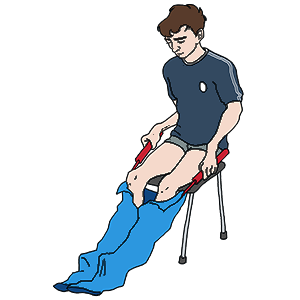
There are clothes and shoes that are designed in a way that makes it easier to put it on and take it off. For instance, there are outdoor clothes and shirts with Velcro fastener as an alternative to buttons and zippers. There are also clothes with a special fit for use in a wheelchair, e.g. clothes that are shorter in the front, so that you avoid excess fabric that puff out or creaseswhen you sit, or pants that come up high in the back, so you avoid showing your skin.
Read more in the guide Clothes and Shoes.
Furthermore, there are assistive products that can make dressing and undressing easier, e.g. buttonhooks and dressing sticks. Elastic laces can be relevant if you have difficulty tying your shoes or reaching down to your feet.
Read more in the guide Assistive Products for Dressing and Undressing.
Meals and cooking
If you have reduced strength in your hands and fingers and therefore have an insecure grip, you may need cutlery with an adapted grip for meals. For instance, the handle can be thickened, so that it is easier to grab and hold on to.
Read more in the guide Special Cutlery.
There are also specially designed mugs and plates, for instance, mugs in an hourglass shape or with a special handle, which can make it easier to drink, and plates with edges, which make it easier to scoop the food up.
Read more in the guide Plates and Mugs with Special Design.
For cooking, a number of assistive products can be useful. For instance, with packaging openers you can open storage jars, cans or screw caps with less effort. It can also be a good idea to use non-slip mats, which prevent bowls, glasses, or plates from sliding on the table.
Read more in the guide Assistive Products for Cooking.
Mobility and transport
If you have challenges with your mobility or difficulty transporting groceries or other items, there are a number of assistive products that may be relevant.
Walking sticks and rollators
If you have reduced standing and walking ability, there are assistive products that can relieve or support you when you walk. It could be a walking stick if you need mild support or a rollator if you need more support. Most rollators for outdoor use have a seat that you can rest on, on the way. If you need even more support, you can use a walking table or a rollator with high forearm supports.
You can read about choosing and the use of assistive products for walking in the guide Walking Sticks and in the guide Rollators.
Drop foot splints and stimulators
With MS, you may experience that your foot begins to drag when you walk. It is called “drop foot”. There are various options to remedy this, for instance with a drop foot splint (ankle-foot orthosis) or with a drop foot stimulator (functional electrical stimulator).
Wheelchairs
A wheelchair may be the solution if your walking ability is affected to such a degree that you either cannot walk, even with support (a rollator or similar), or if you can only walk very short distances. Depending on how much walking ability you have and how great your need is to get around independently, there are different types of wheelchairs to choose from. The more you need to use the wheelchair, the more carefully it must be selected and adapted with the help of a professional. This applies to both manual and electric wheelchairs.
In the guide Transportation Wheelchairs you can read more about the simplest manual wheelchairs, which are designed for transportation over short distances. In the guide Powered Scooters you can read about the choice and use of powered scooters. If you have a manual wheelchair, you will be able to get tips for e.g. sitting position, driving technique, and maintenance in the guide Maintain your Wheelchair and Mobility.
Maintain your Wheelchair and Mobility
If it is difficult for you to get from a wheelchair to, e.g, the toilet or bed, a smaller assistive product for transfer may be relevant. For instance, a sliding board placed between the bed and the wheelchair can enable safe and easy transfer. There are also tyre shells, which you place on the wheelchair’s tyres, which eliminate friction when transferring sideways to and from the wheelchair.
Read more in the guide Sliding boards, Sliding products and Swivelling Cushions.
Cycling
Perhaps your balance has deteriorated, but that you still have the energy and want to cycle. Tricycles are available with two front wheels or two rear wheels. If you have problems estimating distances, for instance to get around obstacles, it may be an advantage for you to choose a tricycle with two front wheels. Some of the bikes are available with an auxiliary motor, so that you can also manage longer rides. If you cannot ride a cycle independently, a tandem or twin cycle could be an option.
See also the guide Tricycles.
Transport of commodities
When you are shopping, it can be helpful to use a shopping trolley. In this way, it is easier for you to pack your shopping in the trolley while it is placed stably on the floor, and you can also transport them home in an easy and simple way. Some shopping trolleys are also suitable for climbing up and down stairs.
You may also need to transport items around in your home. In this case, a tea trolley would be suitable, as it can prevent fatigue and compensate for a lack of strength or unsafe balance. Tea trolleys are available in different models, and you need to consider, e.g. whether you need one or two push handles, and whether you need the wheels to be suitable for forcing thresholds. If you have to use a tea trolley in your home, it can be an advantage to remove loose rugs, use wedges at the thresholds or possibly have the thresholds removed.
Language and communication
MS can weaken your voice. The most common speech difficulties in people with MS are a weak and/or hoarse voice, often due to lack of air to speak. Furthermore, the articulation may be forced and/or unclear. For some persons, this can lead to withdrawing partially or completely from conversations and discussions.
If you have speech difficulties, we recommend that you seek advice from an audiologist or a professional with knowledge and skills in alternative and augmentative communication. They can advise you on assistive products and how to use them.
SThe Danish Association of Speech, Hearing and Sight Institutions (DTHS) has an overview of municipal and regional institutions giving advice in this area.
Concentration and attention
If your MS has caused reduced concentration and attention, you may for instance have challenges remembering appointments and activities. For some, it can be an advantage to create an overview of the activities and appointments of the day in a timetable or a schedule. Some of these are available as electronic devices or as apps for your smartphone or tablet. Among other things, they may include a reminder function to help you remember tasks and appointments, or a visual countdown timer to see how much time is left of the activity or the day.
Planning and processes
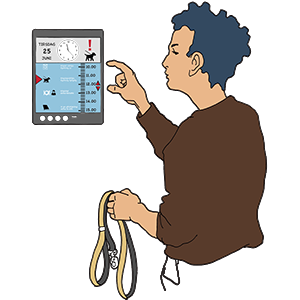
You might find it difficult to plan and stick to the sequence in an activity process, such as making coffee, making dinner or getting ready to go out. In such cases, you can make use of a timetable, possibly with images to make it more comprehensible. For instance, it may be in the form of a list (either paper or electronic) where you can tick off and keep track with how far you are in the process.
Initiative to get started
A possible consequence of MS can be a lack of initiative. This may be manifested in you finding it difficult to get started with tasks that you normally carry out. Assistive products for structure and overview may help you to initiate activities.
You can read more about the various assistive products for structure and overview in the guide Calendars and Timetables, eor you can go directly to the products in AssistData via the following links:
Memory
MS can lead to difficulties with memory. This may be manifested, for instance, in forgetting appointments and names or having difficulty learning new things. There are assistive products that support your memory, e.g. talking photo albums, where you or someone else can record the names of family members in your pictures or stories about holidays, places you have lived, etc. There are also assistive products that give you a reminder about various tasks, e.g. taking your medicine.
A neuropsychologist, an occupational therapist, or other professional within the cognitive field can advise you on which assistive products may best help you and how to use them.
Senses
MS can cause you to have disturbances in the way your senses perceive. You might experience, for instance, that you cannot smell coffee or taste strawberries. You might also not be able to feel what you are holding in your hands, or you might not realize until late that the water from the tap is very hot. If you have difficulty perceiving heat, it may be an option to acquire a water fitting with protection against scalding or with a precise temperature control.
Disturbance of the senses can also cause motor restlessness, increased muscle tension or sleeping difficulties. In such cases, assistive products for sensory stimulation can be useful.
Read more in the guide Assistive Products for Sensory Stimulation.
Vision
If you vision is affected, it can, among other things, result in blurred vision and perhaps pain behind the eyes. Colours and contrasts become less distinct and you may become more sensitive to light. Perhaps your peripheral field of vision or all of your vision is missing for a period of time, or perhaps you perceive a dull spot in the middle of your field of vision.
It is recommended to have a medical assessment and guidance from an ophthalmologist, neuro-optometrist or vision consultant. They will also be able to guide you as to which assistive products can best help you and how to use them.
You can read about some of the different assistive products in the target group entry Visual Impairment.
Sexual activities
In connection with MS, you may experience limitations and losses in your sexual life. This could be, for instance, erectile dysfunction, reduced physical ability, pain or sensory disturbances. Some of the limitations can be remedied with an assistive product.
Many assistive products for sexual activity can be purchased in the general trade. There is also a smaller selection of assistive products for sexual activity in AssistData.
Read more in the guide Assistive Products for Sexual Activity
Incontinence
The brain’s control of the bladder may decrease or cease when you have MS. It can lead to incontinence, which, among other things, can manifest itself in involuntary urination, nightly urination, loss of ability to empty the bladder, etc. If you experience problems with containing yourself regarding urine or stool, you can use different types of diapers or incontinence underwear that can absorb urine and can be washed and reused like regular underwear. It may also be relevant with absorbent covers for the bed, which are available either as disposable underlays or washable for multiple use. In addition, there are alarms that give a signal in case of involuntary urination.
LRead more about the different types of products in the guide Diapers for Adults and in the guide Urine Collectors.


